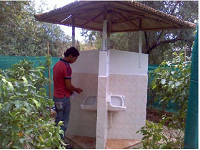/topics/iec
IEC
Behaviour change communication for sanitation
Posted on 09 Dec, 2014 11:18 AMArghyam, a charitable trust working in water and sanitation in India, piloted a behaviour change communication campaign in 25 Gram Panchayats of Davangere district of Karnataka.
Want to build a toilet?
Posted on 22 Nov, 2014 10:30 AMThe Government of Jharkhand has published a technical document in order to encourage the construction and usage of toilets in the state of Jharkhand. The manual begins with an introduction to Nirmal Bharat Abhiyan (NBA), a government programme to tackle open defecation in rural India.

More people power equals more progress
Posted on 22 Nov, 2014 10:30 AMClean surroundings, clean water and a clean toilet – as much as Cuttack, in Odisha is a thriving centre of trade and commerce, it lacked these three basic necessities. An exploratory survey was conducted in 2009 to understand why the city hadn't reached a better state of cleanliness.
How do rural India's toilets measure up
Posted on 22 Nov, 2014 10:30 AMIndia's rural sanitation programme- Total Sanitation Campaign (TSC) was started in 1999, with a goal of eradicating open defecation. Renamed to Nirmal Bharat Abhiyan (NBA) in April 2012, the focus and approach of this programme was supposed to undergo a paradigm shift.

UNICEF launches 'Take Poo to the Loo' campaign
Posted on 22 Nov, 2014 10:30 AMUNICEF's digital media campaign against open defecation
UNICEF launches a three-month long campaign 'Take Poo to the Loo' to raise awareness against defecation in open among the youth.
Wonder women of many Tamil Nadu villages: Water and Sanitation Promoters
Posted on 22 Nov, 2014 10:30 AMSanitation is a familiar term but is often misunderstood to mean the building and using of toilets but this isn’t true. It covers a whole range of thought and action both pre and post latrine use, which includes cleanliness, personal hygiene and the safe disposal of the urine and faeces.

A communication and advocacy strategy framework for sanitation and hygiene by the Ministry of Drinking Water and Sanitation and UNICEF 2012-17
Posted on 22 Nov, 2014 10:30 AMThe number people practicing open defecation in India is more than 600 million. Though the access to improved sanitation has increased since 2000 the pace of change has been slow. If the current trend continues then it will be difficult for the country to meet its Millenium Development Goal for sanitation. Thus accelerating access to and use of toilets and hygiene practices have become a national priority.
A toilet that loves the environment: A film by the Himalaya Seva Sangh highlighting Uttarakhands experience with ecosan toilets
Posted on 22 Nov, 2014 10:30 AMThe Himalayas are inhabited by 40 million people, most of whom are dependent on agriculture and animal husbandry. The prevalent water scarcity also means a lack of water for sanitation. In this case, both open defecation and conventional sewerage pose a health risk. Conventional toilets not only consume a lot of water, but the effluent also pollutes groundwater.

A resource book on waterless urinals: an ecological sanitation method that saves water energy and uses urine as a resource
Posted on 22 Nov, 2014 10:30 AM
Waterless urinals (WLU) save water, energy and use urine as resource ( Image courtesy: R Sakthivel)
Behaviour change towards sanitation and education through art and drama
Posted on 22 Nov, 2014 10:30 AMWith the main objective of creating awareness among the community about the importance of education, open defecation and clean water, HEEALS, a non-profit organization, has collaborated with students from the Central School of Speech and Drama (CSSD), University Of London, to use Applied Theatre as an unconventional and proactive tool to increase awareness among school children in villages and





